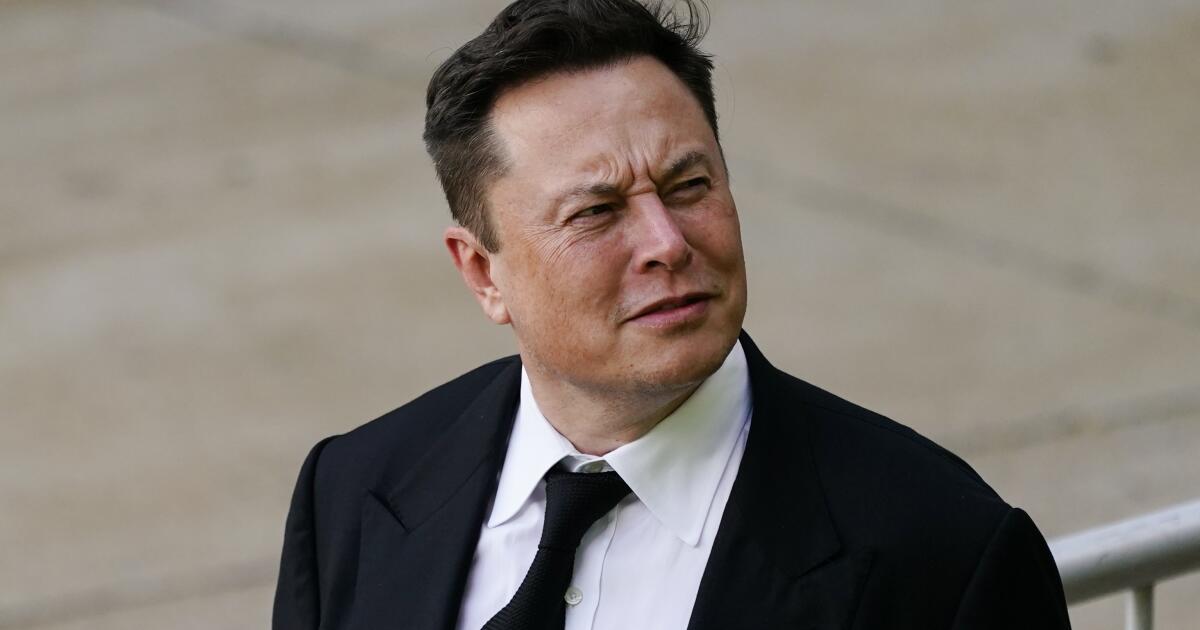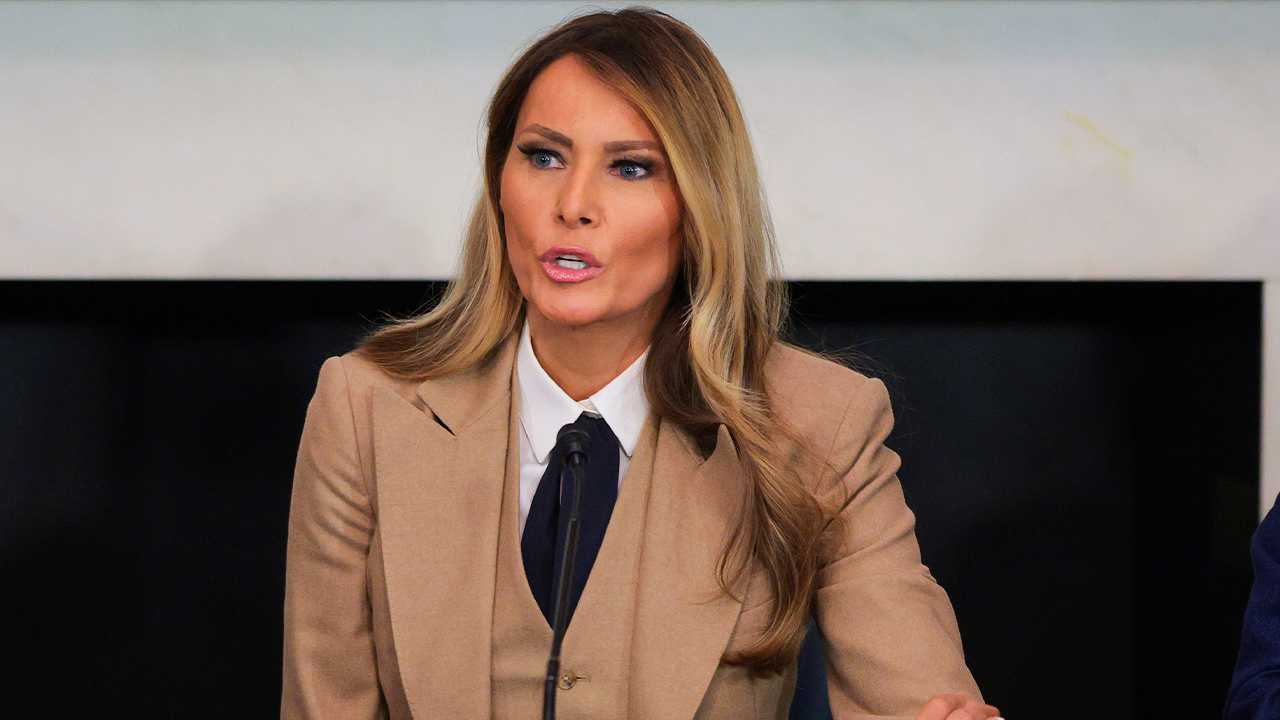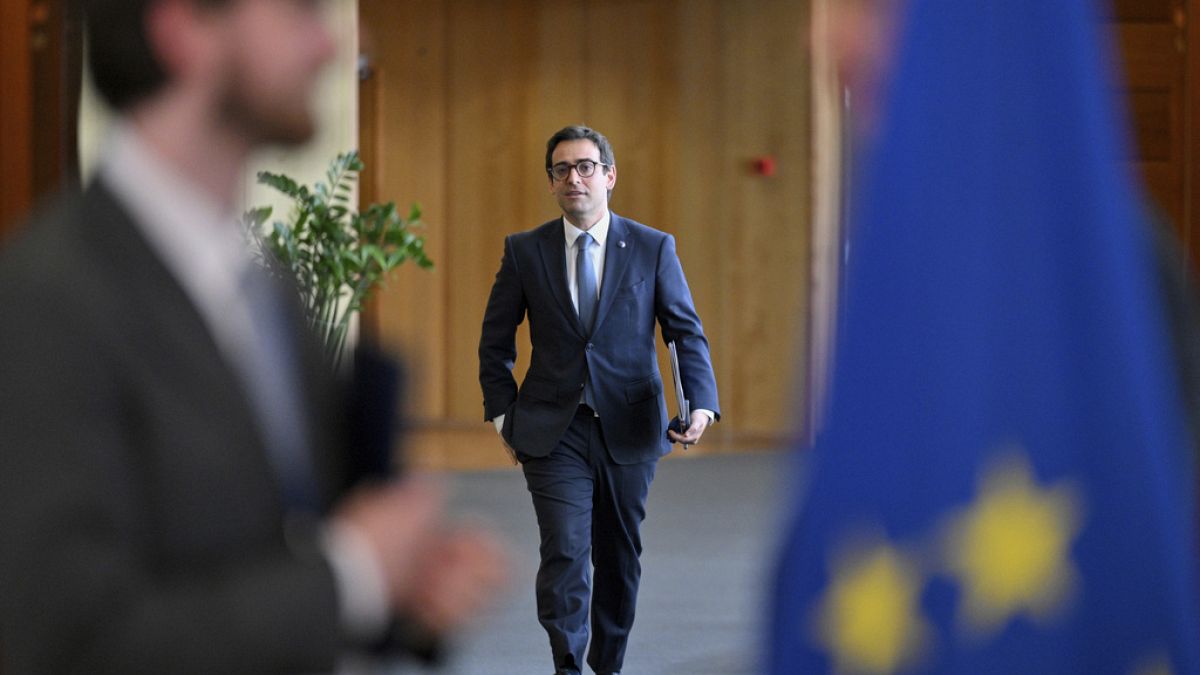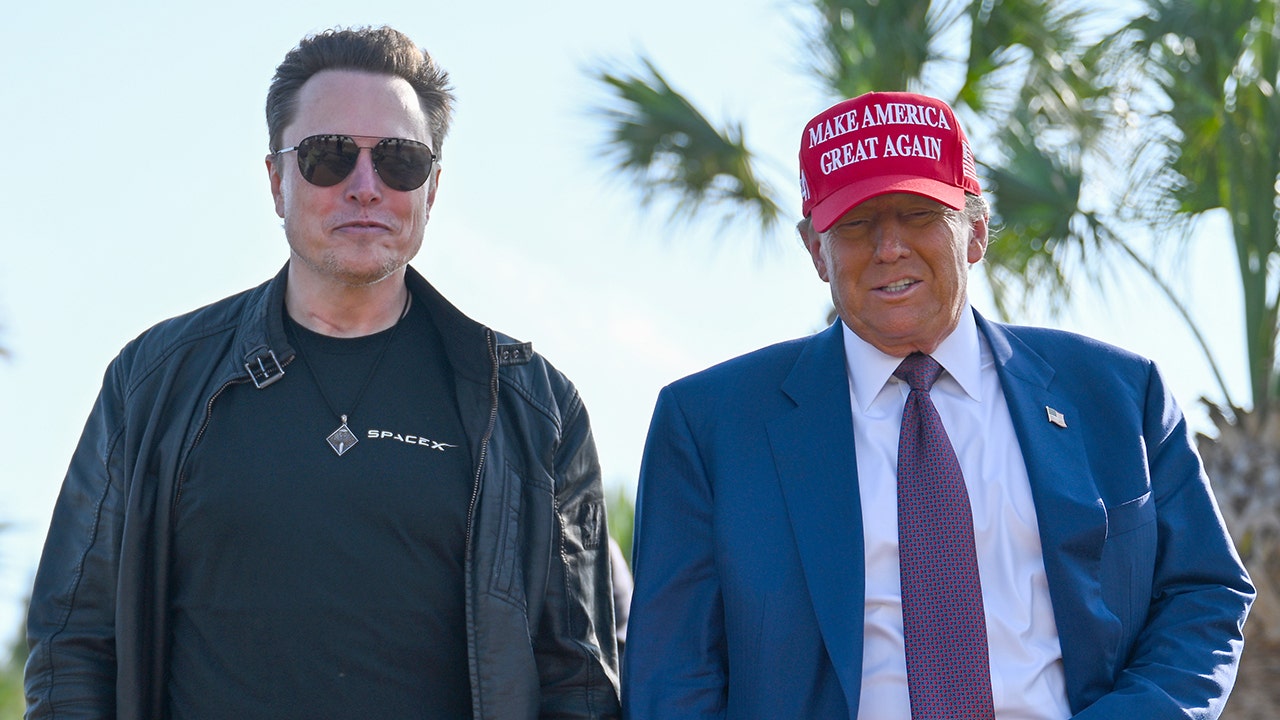Business
Column: With lawsuit against advertisers, Elon Musk plumbs new depths of asininity

Let’s play a parlor game titled “What’s the dumbest thing Elon Musk has ever done?”
Is it promoting tweets from outspoken antisemites and racists on X, formerly Twitter, the social media platform he owns? Embracing antisemitic tweets himself?
Or was it, telling some of the largest corporations in the world to, um, perform a sexual act on themselves because they stopped advertising on the platform? (Warning: Link not safe for work.)
Maybe the top prize goes to his reinstating thousands of accounts of Nazis, white supremacists and disinformation purveyors that had been banned from Twitter by its previous management?
We tried peace for 2 years, now it’s war.
— Elon Musk announces a lawsuit against companies that refuse to place ads on X
Actually, my vote goes to the federal lawsuit X filed on Aug. 6 accusing big advertisers of colluding in a boycott of the platform, ostensibly because they disapprove of its content.
The filing was announced in a video tweet by Linda Yaccarino, the chief executive of X. Yaccarino’s hostage-like affect and her theatrical hand-wavings in the video are so eerie that some viewers speculated, also on X, that the video is an AI-generated deepfake. And why not? Musk himself promoted on X a deepfake fabricating a purported speech by Kamala Harris with the words, “This is amazing.”
The lawsuit targets the World Federation of Advertisers, a networking organization for big advertisers. It specifically names WFA and four companies — the Danish energy company Ørsted, CVS Health and the consumer companies Unilever and Mars. Why it singles out those companies isn’t entirely clear, though it’s notable that they are members or have leadership positions in the Global Alliance for Responsible Media.
GARM, as the lawsuit asserts, was founded to establish brand safety standards for advertisers on X and other social media platforms. In other words, standards to help advertisers keep their messages from showing up alongside posts and accounts promoting hate speech and other noxious messages.
The lawsuit and Yaccarino’s video assert that the advertisers colluded through GARM to boycott X, depriving it of its lifeblood, advertising revenue. “That puts your global town square, the one place that you can express yourself freely and openly, at long-term risk,” Yaccarino said.
Leaving aside this rather inflated and anachronistic description of X — its status as a “global town square” hasn’t survived Musk’s acquisition of the platform in 2022 — the idea that you can sue corporations for deciding not to advertise with you is beyond absurd.
A couple of points about all this:
First, the lawsuit piggybacks on a report issued last month by the Republican staff of the House Judiciary Committee, which is chaired by that outstanding blowhard, Rep. Jim Jordan of Ohio. One in an ever-lengthening line of useless, conspiracy-addled reports from the GOP House caucus — see, for example, its ignorantly anti-scientific screeds about the origins of COVID — this one was oh-so-cleverly titled “GARM’s Harm” and claimed that GARM members colluded to put X out of business.
“I was shocked by the evidence uncovered by the House Judiciary Committee that a group of companies organized a systematic illegal boycott against X,” Yaccarino says, ludicrously.
More to the point, this lawsuit reflects Musk’s habit of blaming X’s financial ills on everyone but himself. Over the last year or so, X has sued the watchdog organizations Media Matters for America and the Center for Countering Digital Hate for trying to “censor” X by asserting — inaccurately, X says — that the platform has become a haven for pro-Nazi content and other hate speech.
Musk also threatened to sue the Anti-Defamation League for purportedly pressuring companies to stop advertising on X because of the apparent rise in hate speech. That lawsuit never materialized. The Media Matters lawsuit is pending. The case against CCDH was thrown out by U.S. Judge Charles R. Breyer of San Francisco in March. More on that in a moment.
Put it all together, and it appears that Musk doesn’t realize that X needs advertisers more than they need X. The platform was generally an also-ran as an advertising medium online, trailing Meta and Google. Under Musk, it may have fallen further behind.
The first hint of the cynicism attending this lawsuit comes from where it was filed. As X notes in its complaint, among the defendants the World Federation of Advertisers is headquartered in Belgium, Ørsted in Denmark, Unilever in London, Mars in Virginia and CVS Health in Rhode Island. X itself is headquartered in San Francisco.
So of course Musk filed the lawsuit in Wichita Falls, a North Texas community with a population of 102,000, which makes it the 39th-largest city — in Texas. What Wichita Falls does offer litigants of a certain ideological slant, however, is a one-judge federal court.
That judge is Reed O’Connor, a right-wing George W. Bush appointee whose hit parade includes rulings invalidating government anti-discrimination laws protecting transgender rights, blocking a COVID vaccine mandate for Navy SEALs and declaring the entire Affordable Care Act unconstitutional. (That last ruling was overturned by the Supreme Court, 7 to 2.)
O’Connor, by the way, is also presiding over the lawsuit against Media Matters. A year ago he reported owning shares worth $15,001 to $50,000 in Tesla, the electric vehicle company Musk controls.
Unsurprisingly, none of these lawsuits alludes, even in passing, to the possibility that the steep decline in revenues or advertising from major consumer firms at X might have something to do with Musk’s policies and behavior.
The lawsuits generally describe their goal as the protection of free speech and open debate online, and present X as the innocent target of one cabal or another.
Judge Breyer in San Francisco made short of that claim in his dismissal of the lawsuit against CCDH; indeed, he found that the shoe was on the other foot. “This case is about punishing the Defendants for their speech,” he ruled. (My emphasis.) He rejected X’s assertion that it had lost “at least tens of millions of dollars” because of CCDH’s reports of the presence of hate speech on X, finding that the platform couldn’t document that its losses were traceable to CCDH reporting or that the money could be recovered even if it could do so.
“X Corp.’s motivation in bringing this case is evident,” Breyer ruled. “X Corp. has brought this case in order to punish CCDH for CCDH publications that criticized X Corp. — and perhaps to dissuade others who might wish to engage in such criticism.” X’s demand for tens of millions of dollars in compensation, he found, seemed designed to “torpedo the operations of a small nonprofit … because of the views expressed in the nonprofit’s publication.”
That brings us to the new lawsuit, against the World Federation of Advertisers and the four corporations. These are defendants that might not blanch at the cost of defending what might be a frivolous lawsuit, but at some level it seems to have made them nervous: The federation said last week that it is “discontinuing” the Global Alliance for Responsible Media.
Musk and his peanut gallery crowed that this represented a victory, but it’s hardly that. The four corporate defendants — like any members of the federation or GARM — always have the right to make their own decisions about where to place their ads. Indeed, it’s inconceivable that a $60-billion multinational such as Unilever would cede those decisions on its hundreds of brands, which include Ben & Jerry’s, Dove beauty products and Hellmann’s mayonnaise, to outsiders.
It’s true that GARM developed standards to help members assess whether they wanted their ads to appear on social media platforms and methods to ensure that the platforms understood the brands’ concerns. It’s also true that advertisers expressed concerns after Musk’s acquisition, and his firing of most of the staff responsible for trust and safety at X, that the chances their ads would end up cheek by jowl with posts from malodorous tweeters would rise.
But the GOP report acknowledges that GARM offered advice, not mandates, and that its advice was typically solicited by the advertisers themselves. What may have irked the Republicans and Musk is that most of the content that scared advertisers away tended to come from the right-wing fever swamp, which no self-respecting corporation would want to be seen endorsing.
One variety of content involved claims that evidence found on a laptop purportedly belonging to Hunter Biden, the president’s son, suggested Hunter was involved in wrongdoing. “Unilever, through GARM, … expressed issues with Mr. Musk exposing the truth about how Twitter, prior to Mr. Musk’s acquisition, censored the Hunter Biden laptop story,” the GOP report says.
The Biden allegations are cherished by the Republican right wing even though no connection to President Biden has ever been established. The GOP report says claims that “incriminating evidence about the Biden family’s influence peddling was found on Hunter Biden’s laptop … have since been authenticated,” which is untrue; that only underscores that the GOP report was a partisan smear, and not something on which X should rest its legal case.
In any event, the GOP report acknowledges that Unilever is “free to unilaterally stop spending its advertising money on [X],” which apparently has happened. Shed a tear for Musk, if you’re so inclined.
Musk may have turned into the biggest obstacle to the survival of X. Directing a profane insult at big advertisers and treating their refusal to spend their ad dollars at his hobbyhorse as “blackmail,” as he did in November, is hardly a way to cozy up to them.
Musk tried a charm offensive this summer at the Cannes Lion Festival, which brings together international advertisers, telling them they “have a right to appear next to content that they think fits with their brand.” But whatever goodwill he might have generated then evaporated last week with his lawsuit. “We tried peace for 2 years, now it’s war,” he said in announcing the lawsuit.
Meanwhile, Musk’s behavior gets worse. Just last week, the CCDH, freed from the financial burden of defending itself against his lawsuit, reported that his “false or misleading claims about the U.S. elections” have been viewed nearly 1.2 billion times on X, “with no fact checks” such as the “community notes” that often debunk disinformation from other accounts.
Why would any advertisers hoping to attract and keep customers want their ads to be seen on a platform that has become a source of informational sewage? To ask the question is to answer it.

Business
Six Flags to cut 135 jobs at Knott’s, Magic Mountain and other California parks

Six Flags Entertainment Corp. has laid off the presidents of Knott’s Berry Farm and Six Flags Magic Mountain and will cut scores of other jobs in California as part of a major shake-up at the theme park giant.
The company, which operates 42 amusement parks across North America, plans to reduce its staff by 10% in the coming weeks. The cuts will include the president positions at many of its parks, Six Flags spokesperson Sara Gorgon said Tuesday.
In all, the company will eliminate about 135 jobs across its California parks by the end of June. The California parks include Knott’s in Buena Park, Magic Mountain in Valencia, Six Flags Discovery Kingdom in Vallejo and California’s Great America in Santa Clara.
The cost-cutting follows last year’s $8-billion merger of Six Flags with Cedar Fair, making it the largest amusement park operator in North America.
The cuts come during a challenging period for Six Flags and others in the tourism business. The company posted a net loss of $220 million in the first quarter of this year, citing weather variability and economic uncertainty.
State and local tourism officials are projecting a slowdown in travel to California due to Trump’s trade war and deportation policies.
Additionally, smaller theme park operators such as Six Flags struggle to compete with bigger industry players Disney and Universal, which also boast more diverse portfolios with streaming and other media.
The Orange County Register first reported that Knott’s President Jon Storbeck and Magic Mountain President Jeff Harris were among those affected by the layoffs.
Storbeck served as vice president of Disneyland before he joined Knott’s in 2016. Harris had held multiple positions at Six Flags before taking over the president role at Magic Mountain in 2023.
The Charlotte, N.C.-based company said the changes reflect its move toward a regional operating structure, rather than individual parks having their own presidents. Some park presidents will be absorbed into other roles at the company, Gorgon said.
In an earnings call earlier this month, Six Flags Chief Executive Richard Zimmerman had warned the company would significantly restructure and pare down its workforce this year. He said the company remained “firmly on track” to achieve its goal of $120 million in reduced expenses by the end of the year.
Former Cedar Fair CEO Matt Ouimet, who previously led Disneyland, lamented what he called a “parade of departures” from Six Flags in a post on LinkedIn last week. Ouimet said he had chosen to retire before having to vote on the merger because he feared the fallout.
“I recognized that I wasn’t up to watching talented colleagues being asked to exit in order to achieve the cost synergies that were promised to investors,” Ouimet wrote. “This die was cast when the merger agreement was signed.”
Also this month, Six Flags announced it would close its theme park and Hurricane Harbor water park in Bowie, Md., after the 2025 operating season.
Six Flag shares closed at $35.06, up nearly 3% on Tuesday.
Business
Louis Vuitton bets big on Rodeo Drive with new Frank Gehry-designed store

Louis Vuitton is gearing up to go over the top again in Beverly Hills.
With plans for an ultra-opulent hotel on Rodeo Drive stymied by voters two years ago, the Paris fashion house’s owners are back with a proposal for a theatrical flagship store designed by architect Frank Gehry that would anchor the north end of the famous retail corridor.
Luxury goods stores on Rodeo Drive are growing larger as top-shelf retailers increasingly up the ante to dazzle shoppers, and the vision from Louis Vuitton owner LVMH is one of the biggest stores yet with restaurants, rooftop gardens and exhibition space.
Set to open in 2029 pending city approval, the store will stretch through the block from Rodeo Drive to Beverly Drive along South Santa Monica Boulevard. It will be one continuous structure connected across an alley by two pedestrian bridges and a tunnel.
Louis Vuitton said its new store will contain 45,000 square feet on the retail side fronting on Rodeo Drive and an additional 55,000 square feet on the hospitality-focused side of the building off Beverly Drive.
“The new location will take visitors into a full Louis Vuitton lifestyle experience showcasing its diverse universes of products and one-of-a-kind client experiences,” the company said in a statement.
The retail entrance will be on Rodeo Drive, with three floors dedicated to product categories such as women’s and men’s collections, travel, watches and Jewelry, beauty and fragrance. A rooftop level will have private spaces for clients and a garden.
Pedestrians walk past a building at the intersection of Rodeo Drive and Santa Monica Boulevard in Beverly Hills.
(Mel Melcon/Los Angeles Times)
Visitors entering from Beverly Drive will find a cafe and exhibition lobby on the ground floor, two more floors of exhibition space and a rooftop with a restaurant and open-air terrace.
Louis Vuitton representatives declined to offer more details about the exhibitions or the building, but the brand perhaps best known for its signature monogrammed handbags and luggage also has made a reputation promoting art and culture.
In 2014 it opened the Fondation Louis Vuitton in Paris in a building designed by Gehry. The Fondation has art exhibits, concerts, dance performances and organized family activities such as art classes for children.
Gehry has also also collaborated with Louis Vuitton on a collection of handbags reflecting his architectural style, which is known for flowing, curvilinear sculptural forms.
In downtown Los Angeles, Gehry designed the Walt Disney Concert Hall, the Grand L.A. mixed-use complex across the street and the nearby Colburn School performing arts center under construction.
The interior of Luis Vuitton’s Beverly Hills flagship is being designed by another well-known architect, Peter Marino, who designed the existing Louis Vuitton store on Rodeo Drive and the ill-fated Cheval Blanc Beverly Hills hotel intended for the Rodeo Drive site now selected for Louis Vuitton’s new flagship.
New York-based Marino was described by Architectural Digest as “a leading architect for the carriage trade, and the architect for fashion brands.”
Marino once said the Chevel Blanc hotel, which was approved by the city before being vetoed by voters, would improve the pedestrian experience on the northern edge of Rodeo Drive’s famed shopping district, where “people get to the end, shrug their shoulders and walk back.”
The parcels intended for the hotel and now Louis Vuitton are owned by LVMH and were formerly occupied by Brooks Bros. and the Paley Center for Media. The existing unoccupied structures will be razed to make way for the new store.
Merchants on the famous three-block stretch of Rodeo Drive constantly strive to find new ways to call attention to themselves and polish their brand’s image, said real estate broker Jay Luchs of Newmark Pacific, who works on sales and leases of high-end retail properties.
“It’s competitive among brands to always be the best they can be, and they’re not sitting on spaces keeping them stale,” he said. “They’re all always reinventing themselves.”
The expensive changes to their stores are “very obvious,” Luchs said. “It’s almost like an art. The street has different top designers who have made these stores spectacular one after the other.”
Even though retail rents on Rodeo Drive are some of the highest in the country, stores are also getting bigger, the property broker said.
Fifteen years ago, stores on the street were typically 25 feet wide, he said, then gradually many became 50 feet wide, he said. “Now you’re seeing stores 100 feet wide” that may have two different landlords.
A 50-foot lot is “very big,” Luchs said, and can hold a store with 5,000 square feet on each level and may go three stories tall for a total of 15,000 square feet in the store.
The fashion house is also growing in New York, where its flagship store is being replaced with a building that will nearly double its footprint on 57th Street at 5th Avenue, the Architects Newspaper said. Construction has been concealed with a facade that looks like a giant stack of distinctive Louis Vuitton trunks.
Business
Disney vs. YouTube. The fight for talent heads back to court

In the last several years, YouTube has become an increasingly formidable competitor to streaming services and entertainment studios, providing videos from amateur and professional creators, as well as livestreaming major events and NFL games.
Now its growing threat to studios is playing out in the courts.
The Google-owned platform recently poached Justin Connolly, president of platform distribution from Walt Disney Co.
On Wednesday, Disney sued YouTube and Connolly for breach of contract, alleging that Connolly violated an employment agreement that did not expire until March 2027 at the earliest.
Connolly oversaw Disney’s distribution strategy and third-party media sales for its streaming services like Disney+ and its television networks. He also was responsible for film and TV programming distribution through broadcasting and digital platforms, subscription video services and pay networks.
As part of his role, Connolly led Disney’s negotiations for a licensing deal renewal with YouTube, Disney said in its lawsuit.
“It would be extremely prejudicial to Disney for Connolly to breach the contract which he negotiated just a few months ago and switch teams when Disney is working on a new licensing deal with the company that is trying to poach him,” Disney said in its lawsuit.
Disney is seeking a preliminary injunction against Connolly and YouTube to enforce its employment contract.
YouTube did not immediately respond to a request for comment.
At YouTube, Connolly will be become the company’s head of media and sports, where he will be in charge of YouTube’s relationships with media companies and its live sports portfolio, according to Bloomberg.
YouTube accounted for 12% of U.S. TV viewing in in March, more than other streaming services like Netflix, according to Nielsen. YouTube’s revenue last year was estimated to be $54.2 billion, making it the second-largest media company behind Walt Disney Co., according to research firm MoffettNathanson.
Unlike many other major streaming platforms, YouTube has a mix of content made by users as well as professional studios, giving it a diverse and large video library. More than 20 billion videos have been uploaded to its platform, the company recently said. There are over 20 million videos uploaded daily on average.
Streaming services such as Netflix have brought some YouTube content to their platforms, including episodes of preschool program “Ms. Rachel.”On a recent earnings call, Netflix co-Chief Executive Greg Peters named YouTube as one of its “strong competitors.”
Connolly entered into an employment agreement with Disney on Nov. 6, Disney said in its lawsuit. That contract ran from Jan. 1, 2025 to Dec. 31, 2027, with Connolly having the option of terminating the agreement earlier on March 1, 2027, the lawsuit said.
As part of the agreement, Connolly agreed not to engage in business or become associated with any entity that is in business with Disney or its affiliates, the lawsuit said. Disney said YouTube was aware of Connolly’s employment deal with Disney but still made an offer to him.
Entertainment companies have brought lawsuits in the past to stop executive talent poaching by rivals.
In 2020, Activision Blizzard sued Netflix for poaching its chief financial officer, Spencer Neumann. That case was later closed, after Activision asked to dismiss the lawsuit in 2022.
Netflix years ago also faced litigation from Fox and Viacom alleging executives broke their contract agreements to work for the Los Gatos-based streaming service. In 2019, a judge issued an injunction barring Netflix from poaching rival Fox executives under contract or inducing them to breach their fixed-term agreements.
Editorial library director Cary Schneider contributed to this report.
-

 News1 week ago
News1 week agoMaps: 3.8-Magnitude Earthquake Strikes Southern California
-

 World1 week ago
World1 week agoPortuguese PM’s party set to win general election, fall short of majority
-

 Politics1 week ago
Politics1 week agoAfghan Christian pastor pleads with Trump, warns of Taliban revenge after admin revokes refugee protections
-

 Politics1 week ago
Politics1 week agoTrump, alongside first lady, to sign bill criminalizing revenge porn and AI deepfakes
-

 Movie Reviews1 week ago
Movie Reviews1 week agoReview | Magellan, conqueror of Philippines, as we’ve never seen him before
-

 Education1 week ago
Education1 week agoHow Usher Writes a Commencement Speech
-

 Politics1 week ago
Politics1 week agoExpert reveals how companies are rebranding 'toxic' DEI policies to skirt Trump-era bans: 'New wrapper'
-

 World1 week ago
World1 week agoDigitisation fronts new Commission strategy to boost EU single market
















